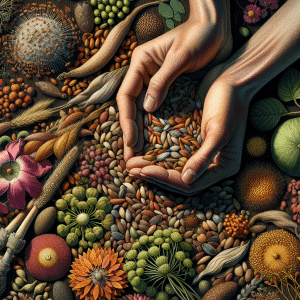Essential Balcony Gardening Tips: Create a Thriving Urban Oasis with These Expert Steps
Choosing the Right Space and Containers
Welcome to the wonderful world of balcony gardening! Have you ever gazed longingly at lush gardens and thought, "I wish I could have that"? Well, the good news is, you can! Even if you live in an apartment with limited space, you can turn your balcony into a vibrant oasis of greenery. But where do you start? Let's dive in!
First things first, take a look at your balcony. Is it sunny, shady, or somewhere in between? Understanding your balcony's sunlight exposure is key to selecting the right plants. Most vegetables and herbs thrive in full sun, so if your balcony receives at least 6 hours of sunlight a day, you're in luck! However, if your balcony is shaded for most of the day, don't worry—there are plenty of shade-loving plants like ferns, begonias, and impatiens that will flourish in your space.
Next, think about the containers you'll use. From traditional pots to hanging baskets and vertical planters, the options are endless! Consider the size of your balcony and how much space you have to work with. If space is tight, vertical gardening might be the way to go. Vertical planters not only maximize space but also add a touch of visual interest to your balcony.
- Assess your balcony's sunlight exposure.
- Choose plants that match your balcony's light conditions.
- Select containers that fit your balcony size and style.
Choosing the Right Soil and Fertilizers
Now that you've selected your plants and containers, it's time to talk about soil. Good-quality soil is the foundation of a successful balcony garden. When choosing soil, look for a well-draining potting mix specifically formulated for container gardening. Avoid using garden soil, as it tends to compact in containers, hindering root growth.
Consider adding organic matter like compost or peat moss to improve soil structure and fertility. This will provide your plants with essential nutrients and promote healthy root development. Remember to choose fertilizers tailored to your plant's needs. For example, vegetables may benefit from a balanced fertilizer high in nitrogen, phosphorus, and potassium, while flowering plants may require a fertilizer with a higher phosphorus content to promote blooming.
When fertilizing your balcony garden, follow the instructions on the fertilizer package and avoid over-fertilizing, as this can lead to nutrient imbalances and damage to your plants. A little goes a long way!
- Select a well-draining potting mix suitable for container gardening.
- Consider adding organic matter like compost to enrich the soil.
- Choose fertilizers tailored to your plants' specific needs and follow instructions carefully.
Protecting Your Balcony Garden
Finally, it's crucial to protect your balcony garden from pests, diseases, and harsh weather conditions. Regularly inspect your plants for signs of pest infestation or disease, such as yellowing leaves, holes in foliage, or unusual spots. If you notice any issues, promptly address them with appropriate pest control measures or treatments.
Additionally, consider installing barriers like mesh screens or row covers to prevent pests from accessing your plants. These barriers can also provide protection against strong winds and excessive sunlight, helping your plants thrive in their balcony environment.
Lastly, monitor the weather forecast and take precautions during extreme conditions like heatwaves or frost. Move sensitive plants indoors or provide shade or insulation as needed to prevent damage.
- Regularly inspect plants for signs of pests or disease.
- Install barriers like mesh screens to protect against pests and harsh weather.
- Monitor weather forecasts and take precautions during extreme conditions.
Frequently Asked Questions
What are the best plants to grow in a balcony garden?
Answer: The best plants for a balcony garden are those that can thrive in containers and adapt to your balcony's specific conditions. Herbs like basil, mint, and chives are excellent choices for sunny balconies, while leafy greens like spinach and lettuce can grow well in partial shade. Flowers such as petunias and geraniums add vibrant color and are also sun-loving. For vegetables, consider growing cherry tomatoes, peppers, and dwarf varieties of cucumbers and beans. It's important to assess your balcony's sunlight and wind conditions to select the most suitable plants.
How can I ensure proper watering for my balcony garden?
Answer: Proper watering is crucial for a successful balcony garden, as container plants tend to dry out more quickly than those in the ground. Here are some tips:
- Check Soil Moisture: Before watering, check if the top inch of soil is dry. If it is, it’s time to water.
- Water Deeply: Water until it runs out of the drainage holes to ensure deep root watering.
- Morning Routine: Watering in the morning helps plants withstand the heat of the day and reduces evaporation loss.
- Self-Watering Containers: Consider using self-watering containers for consistent moisture, especially if you’re frequently away.
How can I maximize space in my balcony garden?
Answer: Maximizing space in a balcony garden involves creative use of vertical and hanging solutions. Here are some ideas:
- Vertical Gardening: Use trellises, wall-mounted planters, or shelving units to grow plants upwards, which is especially effective for climbers like ivy or flowering vines.
- Hanging Planters: Suspend pots from the ceiling or railing to save floor space. This works well for trailing plants like spider plants or petunias.
- Stackable Planters: These allow for growing multiple plants in a tiered arrangement, ideal for herbs or small flowers. By utilizing these methods, you can create a lush and productive garden even in a limited space.
Please Remember
If you’re looking to enhance your gardening skills, especially in limited spaces, We at Limited Space Green Thumb offer a free report about Gardening in Limited Spaces. We also offer an online course on small space gardening techniques.

